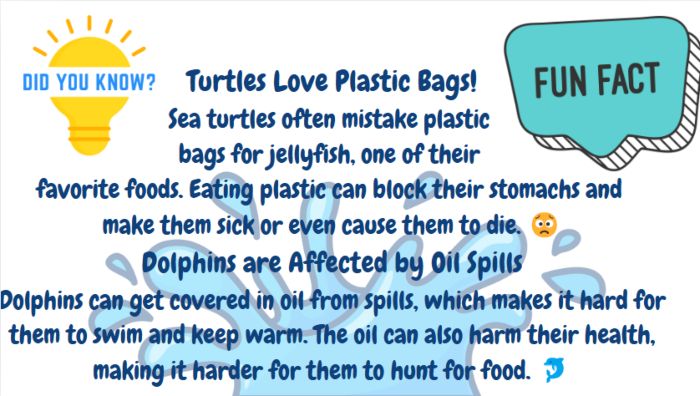Water Pollution
Just To Remind!
Have you ever seen plastic bags or bottles floating in the ocean, harming sea animals?
Or heard about oil spills that cover water and make it unsafe for fish?
Have you noticed dirty rivers or lakes filled with chemicals or sewage, making the water too polluted to drink or swim in?
If yes, then can you list 3 that things cause water pollution?
1)___________
2)___________
3)___________
What is water pollution🫧
Causes Of Water Pollution 🐳
-
Plastic Waste: When we throw plastic bottles, bags, or straws into rivers or oceans, they don't break down and cause water pollution to harm animals living in the water.
-
Oil Spills: When oil leaks from ships or factories, it floats on the water and harms sea animals, making the water unsafe.
-
Factory Waste: Factories sometimes dump chemicals into rivers, lakes, or oceans, which can poison the water and hurt plants and animals.
-
Sewage and Waste: When dirty water from toilets or kitchens isn’t treated properly, it can flow into rivers, making the water dirty and unsafe.
-
Farming Chemicals: Fertilizers and pesticides from farms can wash into nearby water when it rains, polluting lakes and rivers.
Types Of Water Pollution 🐬
-
Plastic Pollution: This happens when plastic items like bottles, bags, and straws end up in the water, harming animals and making the water dirty.
-
Chemical Pollution: This occurs when harmful chemicals from factories, farms, or household products spill into rivers, lakes, or oceans, making the water toxic.
-
Oil Pollution: Oil spills from ships, drilling rigs, or factories can float on top of the water, making it difficult for animals to breathe and harming the ecosystem.
-
Nutrient Pollution: When too many fertilizers or animal waste enter water sources, it causes harmful algae to grow, which can block sunlight and oxygen, hurting fish and plants.
-
Sewage Pollution: This happens when untreated human waste or garbage is dumped into rivers or oceans, making the water unsafe and spreading diseases.
Effects Of Water Pollution
-
Harm to Animals: Polluted water can make fish, turtles, and other aquatic animals sick or even kill them. Chemicals, plastic, and oil harm their health and make it hard for them to breathe or find food.
-
Unsafe Drinking Water: When rivers, lakes, or oceans are polluted, the water becomes unsafe for people to drink. Polluted water can spread diseases like cholera and make people very sick.
-
Damage to Ecosystems: Water pollution can destroy entire ecosystems. Plants, fish, and insects all rely on clean water, and pollution can disrupt the balance of these natural systems.
-
Harming Plants: Polluted water can make it difficult for plants in rivers and lakes to grow. Without plants, fish and other animals lose their food and shelter, and the whole ecosystem suffers.
-
Decreased Water Quality: Polluted water becomes cloudy, smelly, and unsafe to use. People can't swim, fish, or play in water when it’s polluted, and it makes the environment less enjoyable for everyone.
So kids, Let's protect our water- by learning preventive measures for water pollution!

Quiz
1. Water pollution can happen when __________ is thrown into rivers or oceans.
a) trees
b) plastic
c) food
d) animals
2. Oil spills in the ocean can __________ the water and harm sea animals.
a) clean
b) color
c) pollute
d) freeze
3. One way to prevent water pollution is by __________.
a) throwing trash in the water
b) using eco-friendly products
c) wasting water
d) ignoring recycling
4. When too many chemicals from farms wash into rivers, it causes __________ pollution.
a) plastic
b) chemical
c) air
d) noise
5. To help stop water pollution, we should __________.
a) litter in rivers
b) dump chemicals in lakes
c) throw trash in the trash can
d) waste water

Practice Worksheets:
Click to download the worksheets for hands-on practice!
Easy Level Worksheets
Intermediate Level Worksheets
Advance Level Worksheets
CBSE Schools In Popular Cities
- CBSE Schools in Bangalore
- CBSE Schools in Mumbai
- CBSE Schools in Pune
- CBSE Schools in Hyderabad
- CBSE Schools in Chennai
- CBSE Schools in Gurgaon
- CBSE Schools in Kolkata
- CBSE Schools in Indore
- CBSE Schools in Sonipat
- CBSE Schools in Delhi
- CBSE Schools in Rohtak
- CBSE Schools in Bhopal
- CBSE Schools in Aurangabad
- CBSE Schools in Jabalpur
- CBSE Schools in Jaipur
- CBSE Schools in Jodhpur
- CBSE Schools in Nagpur
- CBSE Schools in Ahmednagar
- CBSE School In Tumkur











